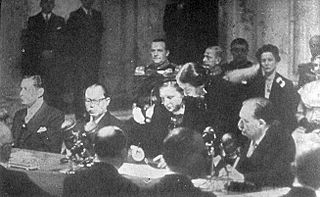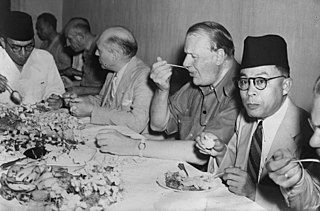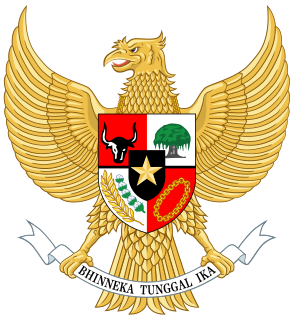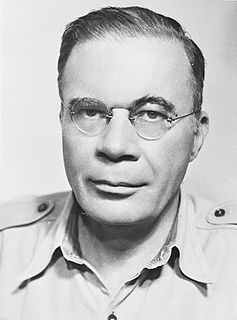
Netherlands New Guinea refers to the Papua region of Indonesia while it was an overseas territory of the Kingdom of the Netherlands from 1949 to 1962. Until 1949 it was a part of the Dutch East Indies. It was commonly known as Dutch New Guinea. It contained what are now Indonesia's two easternmost provinces, Papua and West Papua, which were administered as a single province prior to 2003 under the name Irian Jaya.

The Indonesian National Revolution, or Indonesian War of Independence, was an armed conflict and diplomatic struggle between the Republic of Indonesia and the Dutch Empire and an internal social revolution during postwar and postcolonial Indonesia. It took place between Indonesia's declaration of independence in 1945 and the Netherlands' recognition of Indonesia's independence at the end of 1949.

The Linggadjati Agreement was a political accord concluded on 15 November 1946 by the Dutch administration and the unilaterally declared Republic of Indonesia in the village of Liggarjati, near Cirebon in which the Dutch recognised the republic as the de facto authority in Java, Madura and Sumatra.

The 1949 Federal Constitution of the United States of Indonesia replaced the 1945 Constitution of Indonesia when sovereignty was officially transferred from the Netherlands to Indonesia following the Dutch-Indonesian Round Table Conference. It came into force on 27 December 1949 and was replaced by the Provisional Constitution of 1950 on 17 August 1950.
The Roem – van Roijen Agreement was an agreement made between Indonesian republicans and the Netherlands on 7 May 1949. The name was derived between the two principal negotiators at the meeting; Mohammad Roem and Jan Herman van Roijen. The purpose of the meeting was to iron out outstanding issues prior to Indonesian independence which was to be granted at the Round Table Conference at The Hague later that same year.
Operation Crow was the code name for a Dutch military offensive against the newly formed Republic of Indonesia in December 1948 – January 1949. During this attack, the Dutch managed to capture the Indonesian Republic's temporary capital, Yogyakarta, and seized Indonesian leaders such as Republican President Sukarno.
This is the Timeline of Indonesian National Revolution (1945–1950)

The Dutch–Indonesian Round Table Conference was held in The Hague from 23 August to 2 November 1949, between representatives of the Netherlands, the Republic of Indonesia and the BFO representing various states the Dutch had created in the Indonesian archipelago. Prior to this conference, three other high-level meetings between the Netherlands and Indonesia took place; the Linggadjati Agreement (1947), the Renville Agreement (1948), and the Roem-van Roijen Agreement (1949). The conference ended with the Netherlands agreeing to transfer sovereignty to the United States of Indonesia.

The State of East Indonesia was a post-World War II federal state (negara bagian) formed in eastern Netherlands East Indies by the Netherlands. It was established in 1946, became part of the United States of Indonesia in 1949, and was dissolved in 1950 with the end of the USI. It comprised all the islands to the east of Borneo and of Java.

Ide Anak Agung Gde Agung was an Indonesian politician and the Raja of Gianyar, Bali.
Operation Product was the first of two major Dutch military offensives against areas of Java and Sumatra controlled by the Republic of Indonesia during the Indonesian National Revolution. It took place between 21 July and 4 August 1947. In Indonesia, the military offensive is more commonly known in history books and military records as Agresi Militer Belanda I.

Lieutenant Colonel I Gusti Ngurah Rai was an Indonesian National Hero who commanded Indonesian forces in Bali against the Dutch during the Indonesian War of Independence. He was killed in the Battle of Margarana.
The Malino Conference was organised by the Dutch in the Sulawesi town of Malino from 16–25 July 1946 as part of their attempt to arrange a federal solution for Indonesia. From the end of World War II, Indonesian Republicans had been trying to secure Indonesian Independence from the Dutch colonial control.

The third Sjahrir Cabinet was the fourth Indonesian cabinet. It served from October 1946 to June 1947, when it fell due to disagreements related to implementation of the Linggadjati Agreement and subsequent negotiations with the Dutch.
The Federal Consultative Assembly, (BFO) was a committee established on 8 July 1948 to discuss the form of the planned federal United States of Indonesia. Its membership comprised the leaders of the various federal states established by the Dutch in the areas they occupied following their attack on the areas of Indonesia controlled by republican forces during the Indonesian National Revolution (1945–1949). It took part in negotiations with the Dutch in August and September 1948, and participated in the Dutch–Indonesian Round Table Conference at which the Dutch agreed to hand over sovereignty to the United States of Indonesia.

The Republic of the United States of Indonesia, abbreviated as RUSI, was a federal state to which the Netherlands formally transferred sovereignty of the Dutch East Indies on 27 December 1949 following the Dutch-Indonesian Round Table Conference. This transfer ended the four-year conflict between Indonesian nationalists and the Netherlands that was fought over for control of Indonesia. It lasted less than a year, before being replaced by the unitary Republic of Indonesia.

The military history of Indonesia includes the military history of the modern nation of Republic of Indonesia, as well as the military history of the states which preceded and formed it. It encompassed a kaleidoscope of conflicts spanning over a millennia. The ancient and medieval part of it began as tribal warfare began among indigenous populations, and escalated as kingdoms emerged. The modern part is defined by foreign colonial occupations, battles for independence through guerrilla warfare during Indonesian National Revolution, regional conquests and disputes with neighbouring countries, as well as battles between the Republic and separatist factions. Since the formation of the Republic, the military has played significant role in state affairs. However, in Post-Suharto era, the Indonesian military has retreated from politics, yet it still possesses some influences.
The Denpasar Conference was held from 7 - 24 December 1946 at the Hotel Bali and resulted in the establishment of the State of East Indonesia, part of the United States of Indonesia. It was at this conference that the Dutch government stated its position that control of Western New Guinea would not be handed over at the same time as the rest of the Dutch East Indies.
The Cabinet of the State of East Indonesia was the part of the government of the State of East Indonesia (NIT), and comprised ministers appointed by the head of state. During the three-year lifetime of the state, there were seven cabinets.
















